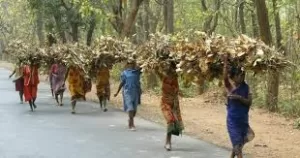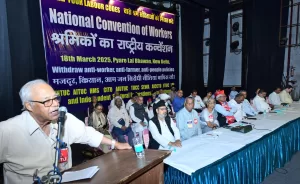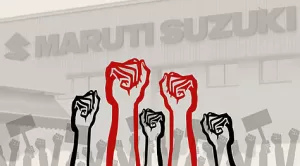The 1990s marked a watershed in the attitude of the Indian state towards labour, with the ushering in of “liberalisation, privatisation and globalisation” (LPG) policies.
The early years of the LPG era saw sensational murders of trade unionists. The theatre activist Safdar Hashmi and members of his troupe, Jan Natya Manch, were brutally attacked with iron rods by the henchmen of a Congress corporator as they performed a street play that campaigned for minimum wages in Jhandapur village in Sahibabad Industrial Area on January 1, 1989. A worker named Ram Bahadur died on the spot; Hashmi succumbed to his injuries the next day. On January 4, 1989, thousands of workers, students, and artists watched the electrifying sight of a grieving Jan Natya Manch led by Hashmi’s partner, Moloyashree, return to perform the unfinished play at the same spot.
In the early hours of September 28, 1991, Shankar Guha Niyogi, a legendary organiser of contract workers in Chhattisgarh, was shot and killed while asleep in his home in Bhilai. Niyogi, a Marxist Leninist, founded the Chhattisgarh Mukti Morcha, an umbrella organisation of workers and peasants centred at the Dalli Rajhara Mines in Chhattisgarh. His union set up schools, a hospital, a cultural troupe, and a football team, and led a massive anti-alcohol movement among the workers. Niyogi left behind a tape-recorded statement that industrialists of the Simplex and Kedia groups and the Inspector General of Police of the BJP State government had hatched a conspiracy to kill him.
On January 16, 1997, Dr Datta Samant, a charismatic leader of the Bombay textile mill strike, was assassinated as he left his house in Powai, Mumbai. By then, around 65 textile mills had shut down and over 2.5 lakh workers had been displaced. The killing was said to have been prompted by the lockout of Premier Automobiles, the issue of mill lands, and trade union rivalry, particularly with the Shiv Sena. It was only in 2023, 26 years later, that the gangster Chhota Rajan was acquitted of the charge of Samant’s murder. In the 1990s, what little was left of the honeymoon between capital and labour in postcolonial India thus came to a bloody end.
The perils of contractualisation
The Contract Labour (Regulation and Abolition) Act, 1970, was a unique piece of Indian labour legislation that saw contractualisation for what it was: an exploitative tool to deprive workers of the benefits accruing to regular employees. It prohibited the use of contract labour in necessary, regular, and perennial work of any establishment. The story of how the law was systematically sabotaged is beyond the scope of this article. Suffice it to say that neither the governments chose to abolish contract labour in various establishments nor did the advisory boards, constituted both at the State and Central levels, have enough powers and efficacy to ensure the same.
The fatal blow, however, was struck by the judiciary in Steel Authority of India Ltd & Ors v. National Waterfront Workers Union & Ors (AIR 2001 SC 3527). This judgment by a seven-judge bench held that even if contract workers had been working for decades against posts where contract labour had already been abolished, they would not get absorbed. In fact, they would all lose their jobs when the establishment carried out “proper recruitment” of eligible candidates “through the front door”. The workers were given a clear signal: “Don’t come to the courts, there is no hope here.”
Of course, this does not mean that there have not been any victories for contract labour in the courts. A notable example was the epic struggle in both the courts and on the streets by the Kachra Vahatuk Shramik Sangh that got regularisation of various batches of contractual safai karmis (sanitation workers) working for decades in the Brihanmumbai Municipal Corporation.
Today, even in large industrial establishments, not even 10 per cent of the workforce is permanent. For instance, at the Bhilai Steel Plant in Chhattisgarh, where there were 96,000 permanent workers in the 1960s, there are now only around 12,000 permanent workers. Meanwhile, the same plant employs more than 50,000 contract workers who earn a fraction of the wages of a permanent worker.
Contractualisation, due to the precarious nature of employment, has many serious implications. First, it makes unionisation virtually impossible. Usually, even before a union can be formally registered, the leaders, if not the entire batch of workers, can easily be fired. Second, these workers possess little documentation even after decades of work—no appointment letters, gate passes, salary slips, and so on—making legal recourse very difficult. These workers are also given the most hazardous and back-breaking of tasks with the longest hours, with permanent employees generally overseeing their work as supervisors. Third, the wages are pitifully low, sometimes even below the notified minimum wage.
Today, 83 per cent of the working class falls outside the fold of organised industrial labour, and 93 per cent is non-formal, that is, has no formal contract. The dismal wage levels of the working class have been starkly described in a recent ILO report. Titled “Wages and minimum wages in the time of COVID-19”, the report says that real wage growth in India was one of the lowest in Asia. India’s “real wage” grew by a paltry 2.8 per cent in 2015, 2.6 per cent in 2016, and 2.5 per cent in 2017, while it remained flat in 2018.
The long road to uncertainty
Contract workers are not entitled to housing or medical benefits or even subsidised food in the canteen as their “regular” counterparts are. Often, these workers are migrants from marginalised backgrounds; this renders them even more vulnerable.
We saw what this meant on our television screens a mere week into the COVID-19 lockdown—the terrible sight of over a crore hungry and desperate migrant workers returning home on foot across the country.
Real wage growth
Even among its immediate neighbours, such as Pakistan, Sri Lanka, China, and Nepal, India’s real wage growth fared badly. Pakistan’s wage grew by 8.9 per cent in 2015, and by 4 per cent each year for the next three years; Vietnam’s grew between 3.7 per cent and 12.4 per cent, while China’s grew by 5.5-7 per cent each year between 2015 and 2018. Even before COVID-19, in 2018, the report claimed that in purchasing power parity terms, India’s gross monthly wage of $215 was the third lowest, after Bangladesh and Solomon Islands, among the 30 countries of the Asia Pacific Region.
A large proportion of migrant workers returned to the cities after the pandemic had passed as agriculture could not support them and rural wages had also declined. According to the ILO, informal workers saw a 22.6 per cent fall in wages post-pandemic, even as formal sector employees had their salaries cut by 3.6 per cent on an average.
Over the years, different sections of the working classes—construction workers, domestic workers, hawkers, home-based workers, Ola/Uber drivers, delivery workers, app-based service workers—have been trying to organise within the special circumstances of their employment. These categories do not conform to the working norms of a regular factory worker since they have (a) shifting sites of work (b) multiple or shifting employers, and (c) fragmented wages which may or may not add up to a minimum wage. While there is a lack of government regulation over employers, in some cases, legal fictions are perpetuated, like app-based workers being called “partners”.
The entire responsibility of the rural health system rests on the shoulders of ASHA and anganwadi workers, who are deemed “volunteers”. They are agitating to be considered as workers with all the concomitant benefits and protection. Some workers, like construction workers, domestic workers, hawkers, and gig workers, have even managed to lobby with the Union or State governments to get special laws enacted for their protection and rights.
It is paradoxical that the proposed Occupational Safety, Health and Working Conditions Code, 2020, which Parliament hastily passed with barely any debate and which is yet to be notified, proposes to repeal many specific enactments, such as the Plantations Labour Act, 1951; the Mines Act, 1952; the Working Journalists Act, 1958; the Motor Transport Workers Act, 1961; the Beedi and Cigar Workers Act, 1966; the Sales Promotion Employees Act, 1976; the Cine-Workers and Cinema Theatre Workers Act, 1981; the Dock Workers Act, 1986; and the Building and Other Construction Workers Act, 1996.
The new labour codes
The implications of this are enormous for each category of workers. If we take just one such Act—the Construction Workers Act—the code has nothing to replace the Act’s scheme of registering and providing identity to workers and to grant some social security benefits using the 1 per cent cess levied on construction activity as the source of funds.
The proposed code even does away with the Factories Act, without incorporating the protective provisions added to it after the terrible corporate crime of the Bhopal Gas tragedy, which, incidentally, marked its 40th anniversary on December 3, 2024. The code also intends to repeal the Contract Labour (Regulation and Abolition) Act, 1970, thus changing the status of abolition of contract labour from the “extremely difficult” to the “impossible”. In fact, by making unionisation more difficult and by proposing “fixed term contracts”, the new labour codes are making sure that the permanent worker stands to be abolished.
Another extremely problematic aspect of recent law-making are the new debt recovery, insolvency, and bankruptcy laws. While the old Companies Act, 1956, had provisions for winding up and liquidating companies and the recovery of debts by creditors, it recognised that the dues of workers stood on an altogether different footing from such debts.
Provident Fund (PF) and gratuity were supposed to be non-negotiable and protected dues of workers; in fact, PF was the first charge on an employer’s assets. Thus, Section 529A of the Companies Act, 1956, or the comparable Section 326 of the Companies Act, 2013, clearly classifies workers dues as “overriding preferential dues”.
However, the Securitisation and Reconstruction of Financial Assets and Enforcement of Security Interest Act, 2002, and the Insolvency and Bankruptcy Code are totally focussed on recovery of debts by banks and do not give any preferential place, either statutorily or even procedurally, to workers’ dues. While debts to banks may run into crores and the dues to workers are in lakhs, there is an enormous difference in implication, because for workers, getting or not getting the dues is the difference between life and death for their families. Getting dues “proportionately”, or pari passu as the legal maxim goes, would be a grave miscarriage of justice indeed.
Despite these enormous obstacles, the working class does not stop fighting—be it anganwadi workers pouring into Mumbai’s Azad Maidan to demand better wages, the workers of the Samsung factory in Chennai insisting that their union be recognised, the tea estate workers of West Bengal demanding minimum wages, or the workers of Maruti Suzuki demanding reinstatement after 12 years of incarceration. Even if they are ignored by the media and the powers that be, they are very much there, everywhere, invisible like the dust, and just waiting for a storm to enter our eyes.
(Sudha Bharadwaj is a trade unionist and human rights lawyer. Having spent more than three decades in Chhattisgarh, she now lives in Mumbai as an undertrial in the Bhima Koregaon case. Courtesy: Frontline magazine, a fortnightly English language magazine published by The Hindu Group of publications headquartered in Chennai, India.)
.




